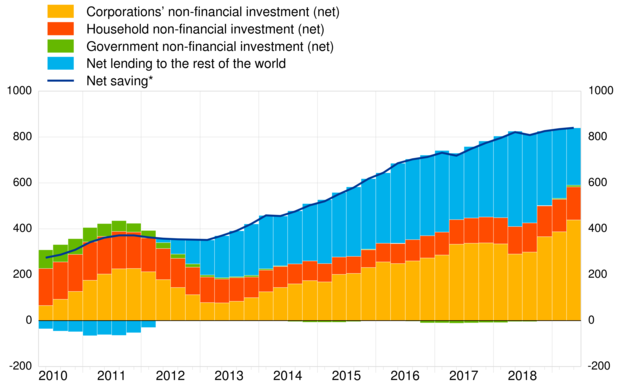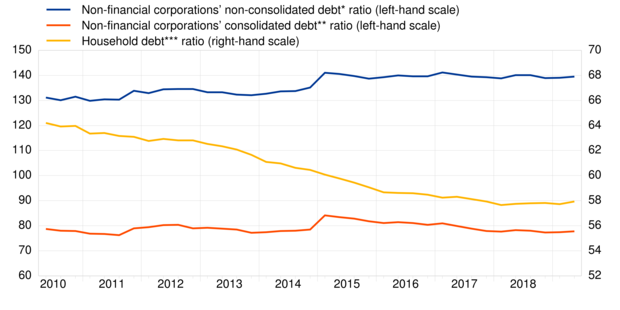- PRESS RELEASE
Euro area economic and financial developments by institutional sector: second quarter of 2019
29 October 2019
- Euro area net saving increased to €828 billion in the four quarters to the second quarter of 2019, compared with €824 billion in the four quarters to the previous quarter (see Chart 1). Euro area net non-financial investment increased to €590 billion (from €533 billion previously), mainly due to increased investments by non-financial corporations. Euro area net lending to the rest of the world decreased to €251 billion (from €301 billion previously).
The household debt-to-income ratio[1] stood broadly unchanged, at 93.5% in the second quarter of 2019 compared with the second quarter of 2018. Non-financial corporations' debt-to-GDP ratio (consolidated measure, see below) decreased to 77.3% in the second quarter of 2019, from 77.7% in the second quarter of 2018; the non-consolidated, wider debt measure decreased to 139.5%, from 140.2% (see Chart 2).
Additional data made available for non-financial corporations and the MFI sector:
(1) From this press release, a consolidated measure for the debt of non-financial corporations is shown in addition to the non-consolidated measure. The consolidated measure for non-financial corporations’ debt covers loan and debt securities liabilities, but excludes debt positions between non-financial corporations.[2] The nature and statistical coverage of intra-non-financial corporations debt varies from country to country. Consolidated debt has therefore become the preferred measure for cross-country comparisons.[3] In addition to consolidated debt, the ECB will continue to publish the wider, non-consolidated measure. It includes loans and debt securities (including positions between non-financial corporations), as well as liabilities from pension schemes and trade credits. Non-consolidated debt is therefore always higher than consolidated debt.[4]
(2) Furthermore, the MFI sector for the euro area is reported with a breakdown between the Eurosystem and other MFIs.[5] The Eurosystem comprises the ECB and the NCBs of those countries that have adopted the euro. In parallel, the national data of euro area countries also include a new breakdown of the MFI sector for the sub-sectors (national) central bank as well as other MFIs.
Total euro area economy
Euro area net saving increased to €828 billion (8.7% of euro area net disposable income) in the four quarters to the second quarter of 2019 compared with €824 billion in the four quarters to the previous quarter. Euro area net non-financial investment increased to €590 billion (6.2% of net disposable income), owing mainly to increased investment by non-financial corporations (see Chart 1).
Euro area net lending to the rest of the world decreased to €251 billion (from €301 billion previously) reflecting the increased net non-financial investment. Net lending by households increased to €279 billion from €258 billion (2.9% of net disposable income), while that of financial corporations stood broadly unchanged at 1.2% of net disposable income. Non-financial corporations recorded net borrowing of €58 billion (-0.6% of net disposable income, down from 0% previously) and net borrowing by the government sector stood at -0.9% of net disposable income.
Chart 1
Euro area saving, investment and net lending to the rest of the world
(EUR billions, four-quarter sums)

* Net saving minus net capital transfers to the rest of the world (equals change in net worth due to transactions).
Households
The annual growth rate of household financial investment increased to 2.4% in the second quarter of 2019, from 2.2% in the previous quarter. Accelerating investment in life insurance and pension schemes as well as currency and deposits, together with slower net sales of shares and other equity were only partially offset by a switch from small net purchases to net sales of debt securities.
Households continued to sell debt securities (in net terms) issued by MFIs and other financial institutions, and they decelerated buying debt securities issued by general government. Households were also net sellers of investment fund shares while investment in listed shares increased. Regarding the latter, they were net sellers of listed shares of non-financial-corporations, and net buyers of listed shares of MFIs, other financial institutions and rest of the world (see Table 1 below and Table 2.2. in the Annex).
The household debt-to-income ratio[6] stayed broadly unchanged at 93.5% in the second quarter of 2019, whereas the household debt-to-GDP ratio slightly increased, to 57.9% in the second quarter of 2019 from 57.7% in the second quarter of 2018 (see Chart 2).
Table 1
Financial investments and financing of households, main items
(annual growth rates)
Financial transactions |
|||||
2018 Q2 |
2018 Q3 |
2018 Q4 |
2019 Q1 |
2019 Q2 |
|
Financial investment* |
2.1 |
2.0 |
2.0 |
2.2 |
2.4 |
Currency and deposits |
3.7 |
3.7 |
4.1 |
4.9 |
5.0 |
Debt securities |
-9.0 |
-6.1 |
-3.2 |
1.2 |
-3.4 |
Shares and other equity |
1.0 |
0.5 |
0.2 |
-0.5 |
-0.1 |
Investment fund shares |
3.1 |
2.1 |
0.1 |
-1.3 |
-0.3 |
Life insurance and pension schemes |
2.3 |
2.3 |
2.0 |
2.0 |
2.3 |
Financing** |
3.0 |
2.9 |
3.2 |
3.3 |
3.3 |
Loans |
3.0 |
3.1 |
3.3 |
3.3 |
3.4 |
* Items not shown include: loans granted, prepayments of insurance premiums and reserves for outstanding claims and other accounts receivable.
** Items not shown include: financial derivative's net liabilities, pension schemes and other accounts payable.
Chart 2
Debt ratios of households and non-financial corporations
(debt as a percentage of GDP)

* Outstanding amount of loans, debt securities, trade credits and pension scheme liabilities.
** Outstanding amount of loans and debt securities, excluding debt positions between non-financial corporations.
*** Outstanding amount of loan liabilities.
Non-financial corporations
In the second quarter of 2019 annual growth of financing of non-financial corporations declined to 1.4%, after 1.7% in the previous quarter, reflecting in particular slower financing by trade credits and advances and other liabilities. The annual growth rate of loan financing stood unchanged at 1.9%, reflecting a decrease in the growth rate of loans granted by other resident sectors offset by an increase in the growth rate of loans granted by MFI and rest of the world sectors (see Table 2 below and Table 3.2. in the Annex).
Non-financial corporations' debt-to-GDP ratio (new consolidated measure) decreased to 77.3% in the second quarter of 2019, from 77.7% in the second quarter of 2018; the non-consolidated, wider debt measure decreased to 139.5%, from 140.2% (see Chart 2).
Table 2
Financial investments and financing of non-financial corporations, main items
(annual growth rates)
Financial transactions |
|||||
2018 Q2 |
2018 Q3 |
2018 Q4 |
2019 Q1 |
2019 Q2 |
|
Financing* |
2.2 |
2.1 |
1.6 |
1.7 |
1.4 |
Debt securities |
5.1 |
5.3 |
4.2 |
4.2 |
4.5 |
Loans |
3.8 |
4.1 |
3.1 |
1.9 |
1.9 |
Shares and other equity |
0.7 |
0.5 |
0.2 |
0.5 |
0.4 |
Trade credits and advances |
7.2 |
6.1 |
4.3 |
4.9 |
2.8 |
Financial investment** |
3.5 |
3.3 |
2.3 |
2.2 |
1.6 |
Currency and deposits |
5.5 |
4.9 |
4.4 |
5.7 |
4.8 |
Debt securities |
-6.1 |
-8.5 |
1.2 |
-2.6 |
-5.2 |
Loans |
5.3 |
5.1 |
2.9 |
1.5 |
1.4 |
Shares and other equity |
1.6 |
1.8 |
1.5 |
1.7 |
1.5 |
* Items not shown include: pension schemes, other accounts payable, financial derivative's net liabilities and deposits.
** Items not shown include: other accounts receivable and prepayments of insurance premiums and reserves for outstanding claims.
Annexes
For media queries, please contact Stefan Ruhkamp, tel.: +49 69 1344 5057.
Notes
- These data come from a second release of quarterly euro area sector accounts from the European Central Bank (ECB) and Eurostat, the statistical office of the European Union. This release incorporates revisions and completed data for all sectors compared with the first quarterly release on "Euro area households and non-financial corporations" of 4 October 2019.
- The debt-to-GDP (or debt-to-income) ratios are calculated as the outstanding amount of debt in the reference quarter divided by the sum of GDP (or income) in the four quarters to the reference quarter. The ratio of non-financial transactions (e.g. savings) as a percentage of income or GDP is calculated as sum of the four quarters to the reference quarter for both numerator and denominator.
- The annual growth rate of non-financial transactions and of outstanding assets and liabilities (stocks) is calculated as the percentage change between the value for a given quarter and that value recorded four quarters earlier. The annual growth rates used for financial transactions refer to the total value of transactions during the year in relation to the outstanding stock a year before.
- The next release of the Household Sector Report containing results for the euro area and all EU countries is scheduled for 11 November 2019.
- Hyperlinks in the main body of the press release lead to data that may change with subsequent releases as a result of revisions. Figures shown in annex tables are a snapshot of the data as at the time of the current release.
- Calculated as loans divided by gross disposable income.
- Consolidation in the institutional sector accounts refers to the exclusion of intra-sectoral financial positions, e.g. loans between non-financial corporations and debt securities issued and held by non-financial corporations. Consolidated debt for non-financial corporations requires who-to-whom data for loans and debt securities; the data availability for consolidated debt is more limited due to limitations in the availability of debt securities data. The ECB publishes quarterly consolidated debt for all EU countries based on the available who-to-whom data.
- The consolidated debt concept is in line with the private sector debt indicator in the macro-economic imbalance procedure (MIP) surveillance mechanism of the European Commission.
- For more detail on the different measures of NFCs debt see: NFC debt concepts: Debt of non-financial corporations (Oct. 2019). For the usage of the different debt concepts, see the box entitled “Debt of non-financial corporations: consolidated and non-consolidated measures”, in the Monthly Bulletin, ECB March 2014: https://www.ecb.europa.eu/pub/pdf/mobu/mb201403en.pdf.
- See http://sdw.ecb.europa.eu/reports.do?node=1000006424.
- Calculated as loans divided by gross disposable income.
Euroopa Keskpank
Avalike suhete peadirektoraat
- Sonnemannstrasse 20
- 60314 Frankfurt am Main, Saksamaa
- +49 69 1344 7455
- media@ecb.europa.eu
Taasesitus on lubatud, kui viidatakse algallikale.
Meediakontaktid

